PreTents Soloist: Lightweight tent review
A couple of years ago, I wrote a review of a new tent from PreTents, the Ridgeline two-person expedition tent. The flexibility and practicality was impressive, although you may have had some reservations about the lack of space for two people to live in the tent comfortable for extended periods. When it came time to buy a tent, I wanted an ultralight one-person tent for solo adventuring (or adventuring with friends who are responsible for their own sleeping set-up) but had been sufficiently impressed by the PreTents to look closely at their range and ended up buying the PreTents Soloist (purchased from the superb Valley and Peak outdoor store).
PreTents focus is on small, lightweight, robust tents for fairly serious hikers and trekkers. They’re keen on innovative features and practicality, which I like, and have a coherent range covering one, two and four-person free-standing tents as well as some trekking-pole-supported ones, like this one.
Using a trekking pole to support your tent can massively reduce weight and bulk. Can because that’s on the assumption you’d be carrying trekking poles anyway. If you don’t walk with poles and are carrying them just to support the tent then clearly the saving is less relevant… As it happens I do use trekking poles, so being able to do away with even the very lightweight poles that modern tents comes with can save a good chunk of weight as well as leaving the tent as little more than a soft tarp that can be squashed into just about any space in your pack.
One important thing to be aware of is that except in rare cases (PreTents does make a 4-person pole-supported tent with some inbuilt poles to add height) the maximum height of a trekking-pole-supported tent is restricted to the length of the pole. In addition, since most are supported on just one central pole, pole-supported tents tend to be at the tallest in one spot and then drop sharply at the sides. This means head room is inevitably limited and, while I’ll talk a bit about that in this review, it is in part a natural feature of trekking-pole-supported tents and not a criticism.
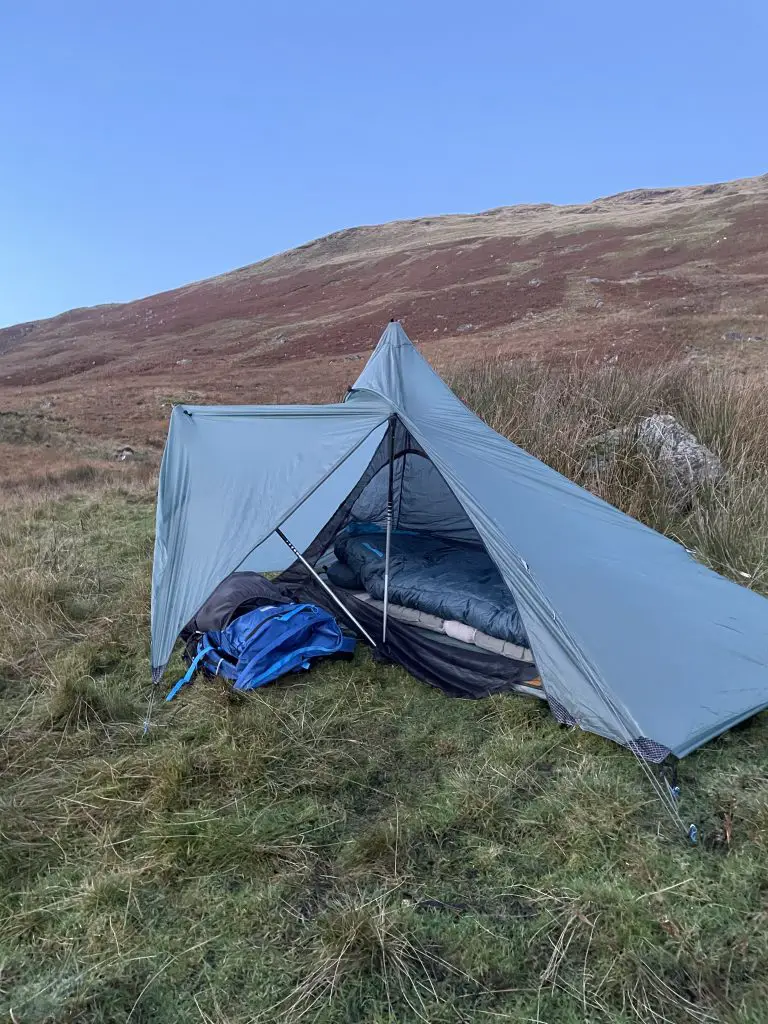
Testing conditions and criteria
I’ve tested the tent in a few different conditions, including some wild camping in the Trossachs in Scotland. During that trip I had some heavy rain overnight, although I wasn’t met with the windiest conditions I’ve ever had on a hike, so my comments on the tents performance in strong winds will slightly be supposition.
In terms of review criteria, I’m interested in particular in:
- Weight and bulk when disassembled and stowed away.
- How easy the tent is to put up and take down, especially in challenging conditions.
- How easy it is to live in the tent – everything from size and space to features, ease of getting in and out, places to put things, and so on.
- How well the tent stands up to weather, both bad weather (wind, rain and cold) but also camping in hotter conditions.
First impressions, and weight and bulk
The Soloist comes in a single bag, only very slightly larger than a standard nalgene bottle, which contains the tent outer and inner rolled up together, and a small bag of DAC tent pegs. It all weighs in at 750g which is extremely light. To go much lighter than that, you’d be looking at using just a tarp – and indeed that is pretty much an option with the PreTents as its very easy to do away with the inner if you wish. More on that in a bit.
By not having poles, the tent is also easy to squash into almost any space. I carried it shoved into the side-pocket on my bag, where it fitted nicely.
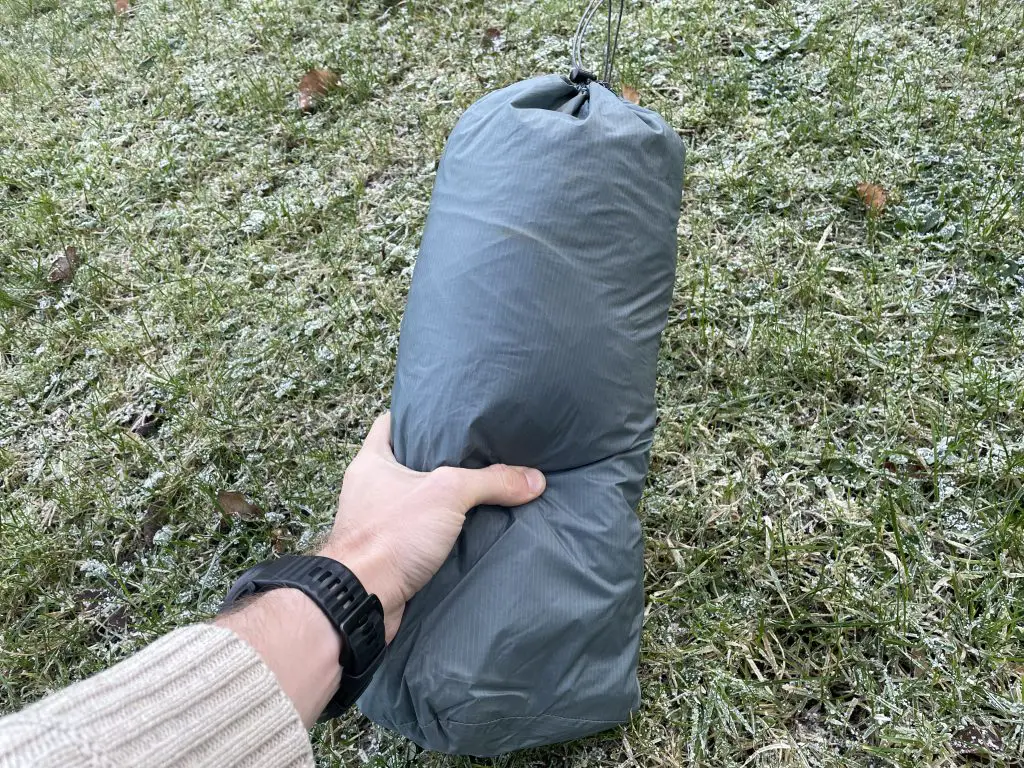
PreTents Soloist specifications and features
You wouldn’t expect a minimalist tent to have a tonne of ‘features’ and, indeed, this one doesn’t – really. But PreTents do take a lot of care to make their tents usable, and this is no exception.
Starting from the inside, then, the inner is extremely simple with a rectangular footprint just barely larger than an average sleeping mat. The floor, and a small lip around all four sides, is made from 30D Ripstop Nylon. The remainder of the inner is made from lightweight mesh and gathers up to a single central point, offset slightly on the short axis on the basis that the pole will not be in the middle of the tent. The mesh is mainly for insect protection although it also does something to keep off any light drips of condensation from the outer. It has one large zip door, and a couple of little pockets inside for essentials such as a phone or a torch.
As discussed above, you could save weight by doing away with the inner and just using the outer as a shaped tarp to sleep under. You’d lose the insect protection, which may or may not matter depending where you are, and of course would be sleeping directly on the ground so would likely want either a groundsheet or a bivvy bag, although of course you may be happy to put your sleeping mat directly on the ground. The advantage of this approach aside from reducing weight further and simplifying set-up is that you’d gain a bit of extra headroom.
The outer is a similar shape, with a reinforced central (or almost-central, again it’s offset slightly so that the pole is off to one side of you) point for your hiking pole to rest in, and steep sides that go down to peg points at four corners and both long sides. Mid-way up each corner there is also an adjustable guy-line that you could peg out for extra stability, although this isn’t mandatory and in several of the official pictures these aren’t pegged out.
One one long side is the door – a slightly unusual design that is fixed at the top, with zips on either side allowing you to open the tent and slip out, or roll one or both sides back to create an open doorway. In addition, by unzipping one or both zips you can then prop the door up on your second hiking pole, add tension with guylines, and create a fly-porch that offers some rain cover for you to cook or admin yourself in. Personally, it wasn’t obvious to me while I was putting up the tent in the rain on a dark night exactly how to do this, and I made a slightly bodge job of it that, on later examining the official pictures, does not represent how PreTents intend you to use the door, but it worked well enough and was a handy feature and somewhere to put bits and pieces of kit out of the rain while I got ready for bed.
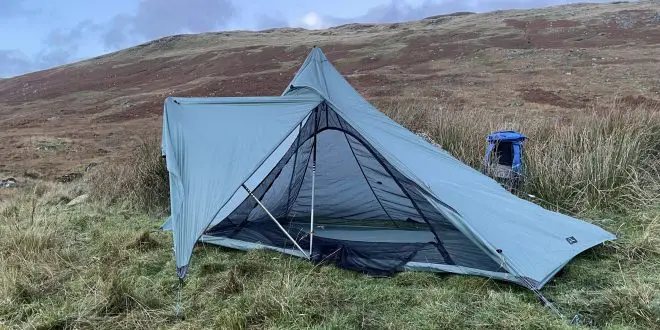

Putting up the PreTents Soloist
Aside from the door, the tent isn’t overly difficult to put up. Peg out all four corners, put the pole in, add tension as needed and adjust. It’s equally quick and easy to take down and, with practice, both could probably be done in a few minutes. It’s also straightforward to be done by one person, and in rain or moderate wind. What is nice is that the inner can remain attached to the outer and the corners are pegged ‘as-one’ so largely the tent can be put up as a single piece without having to worry about doing the inner and outer separately.
Comfort and usability
Where a lightweight, solo, trekking-pole-supported tent is inevitably going to suffer is in comfort. Size, space and especially height will always be a problem. With all of that born in mind, the length of the tent is actually decent, with no issues for me (at 6’2″ / 187cm) while I was lying down. Width is just about adequate, with enough room for my sleeping mat and bag, and then a narrow channel of space where I could put a few essential items that I wanted to keep in the tent. You’d struggle to keep a bag in the tent without seriously compromising space, but there is a small vestibule created between the inner and outer where I was able to just about fit my 42L bag, my boots, and my cooking gear to keep them dry and out of the way overnight.
The biggest issue is height. With my Neo XTherm inflated, I couldn’t sit on it and sit up comfortably anywhere in the tent, not even in the very centre. Part of the issue is that the inner is made of soft mesh and is supported only at the top centre point, where it hangs from the outer, and then at the four corners. In the middle, therefore, it droops inwards and makes the space feel smaller than it really is. It would benefit from additional loops attaching it to the outer at the mid-points of the four corners, although this would of course add weight and possible failure points, and make it harder to detach the inner from the outer.
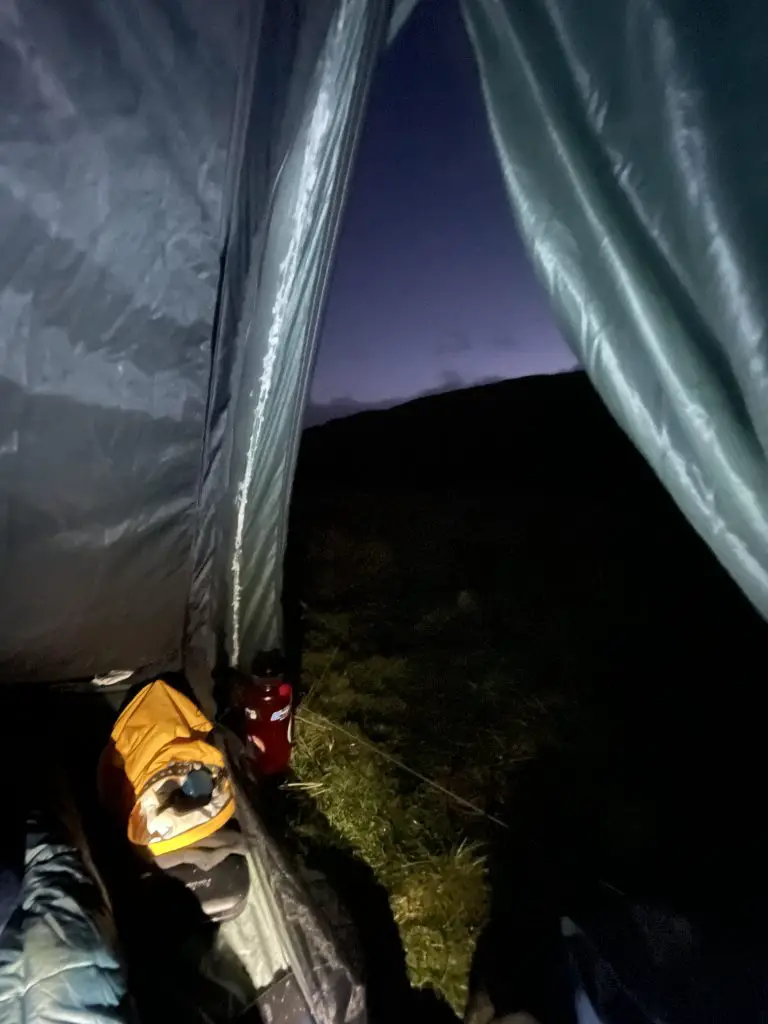
Overall the space was adequate to sit in briefly while doing personal admin, and then to sleep in, but little more. If you were stuck in the tent for a long period during bad weather, it could be tough, and I was fortunate that in the evening I was able to sit outside to cook, as doing it in the tent might have been tricky.
PreTents Soloist resistance to weather
Like all the PreTents range, they save weight by not taping the seams, and so these require seam-sealing before use in poor weather. I’ve never done this before and honestly found it a frustrating process that ended up with seam sealant all over the place, and the inner seams of the tent still look a mess to me. However, that’s my fault I suppose, and I guess it all worked because, even in persistent and quite heavy rain, I found the tent kept me extremely dry. Like any tent, especially a small and essentially single-walled tent, it’s prone to condensation but there’s a reasonable amount of airflow and this wasn’t terrible by any means.
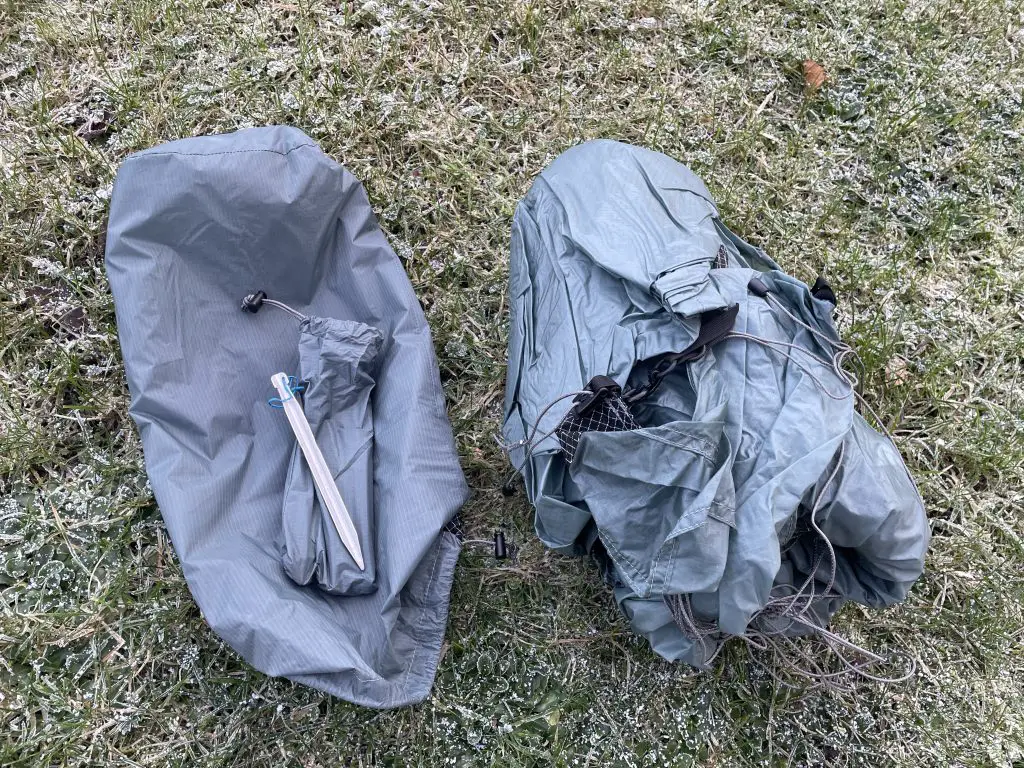
Wind would be my biggest concern with a tent like this. Partly because the single-pole set-up feels inherently flimsy, and partly because it creates large, flat surfaces for the wind to push against, as opposed to the rounder shape of most modern self-supporting tents. I haven’t yet tested it in high enough winds to really know if this is a problem and, in fairness, if it is well pegged out including all the guy-lines, there’s no reason it should be a huge problem. You might, however, find that one wall of the tent flapped or was pushed uncomfortably against you as you slept.
Summary
Buy the PreTents soloist if:
- You want the lightest tent possible and already use hiking poles
- You’re more concerned about reducing weight and bulk than you are about comfort in-camp
- You’re happy to apply seam sealant to the tent yourself (or can find someone to do it for you)
- You like the style and features of the PreTents range
Don’t buy the PreTents soloist if:
- You don’t already use hiking poles
- You’re looking for a tent that you can comfortably sit in while on a camping holiday
- Weight and bulk isn’t a major concern for you when choosing kit





